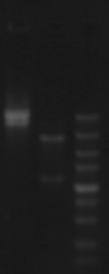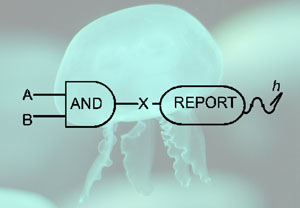Part:BBa_K1223002
P.A.S.E. 2 cassette
Sequence and Features
- 10COMPATIBLE WITH RFC[10]
- 12COMPATIBLE WITH RFC[12]
- 21INCOMPATIBLE WITH RFC[21]Illegal BglII site found at 1025
Illegal BamHI site found at 1193 - 23COMPATIBLE WITH RFC[23]
- 25INCOMPATIBLE WITH RFC[25]Illegal NgoMIV site found at 361
- 1000INCOMPATIBLE WITH RFC[1000]Illegal SapI site found at 301
Illegal SapI site found at 511
Design Notes
this cassette is the heart of the P.A.S.E. 2 (Programmable Autonomous Self Elimination) system. P.A.S.E. 2 cassette is intended to be incorporated into E.coli BL21 genome by recombineering, and therefore has a homolgy region in each side that direct the recombination into the right place in the genome. this cassette is used to replace the native promoter and regulatory sequences upstream of the CDS of the TyrS gene that encodes for the enzyme Tyrosine synthetase. the native promoter is replaced with an IPTG/Arabinose induced promoter (BBa_k354000) and BBa_b0034 RBS. the cassettes has a kanamycin resistance gene (KanR) to aid in selection of the desired transformants.
the sixth amino acid in the TyrS sequence was replaced with an amber stop codon (TAG) in order to further reduce unwanted 'leakage' of the promoter. the TAG stop codon is used for the incorporation of unnatural amino acids (UAAs) into the protein sequence. this system gives us better control of the translation process and prevents expression of TyrS when the unnatural amino acid is not present in the medium. incorporation of unnatural amino acids into the protein sequence require three things: - insertion of the amber stop codon (TAG) in the DNA sequence, where we want the UAA to be incorporated. we also need to replace the stop codon at the end of the CDS to the TGA or TAA stop codons (preferably TAA). - an orthogonal tRNA that will be loaded with the UAA to be incorporated into the protein. - an orthogonal tRNA synthetase that recognizes both the orthogonal tRNA and the UAA.
both the tRNA and the tRNA synthetase are encoded in the UAA incoporation machinery plasmid.
The part was characterized through sequencing and restriction digest with BamHI and XbaI.
lane1: undigested pUC57-P.A.S.E.2 cassette
lane2: pUC57-P.A.S.E.2 digested XbaI and BamHI
lane3: DS5000 ladder
Creating the world’s first UAA logic AND gate
The sixth amino acid in the TyrS sequence was replaced with an amber stop codon (TAG). The TAG stop codon is used for the incorporation of unnatural amino acids (UAAs) into the protein sequence. This system gives us better control of the translation process and prevents expression of TyrS when the unnatural amino acid is not present in the medium. The fail proof aspect of this system is achieved by creating a logic AND gate which is depended on IPTG/Arabinose AND UAA in order to synthesize an active TyrS protein.
Source
this construct was synthesized in one piece. the sources of the sequences used in this part are genbank (TyrS CDS, KanR) and the iGEM catalog (BBa_k354000,BBa_b0034).
References
Wang, L.; Brock, A.; Herberich, B.; Schultz, P. G. Science 2001, 292, 498.
Milles, S.; Tyagi, S.; Banterle, N.; Koehler, C.; VanDelinder, V.; Plass, T.; Neal, A. P.; Lemke, E. A. Journal of the American Chemical Society 2012, 134, 5187.
| positive_regulators |


